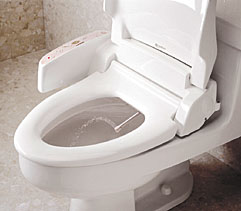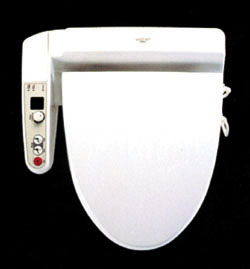
"There is definitely a market for that type of product," says Warren Silver, showroom manager, North Miami, Fla., who oversees six Florida showrooms for Ferguson Enterprises, Newport News, Va.
"Some companies have designed them and then shelved them," he says. "Others have designed them and then marketed them to full fruition."
To increase sales, the industry needs to build greater awareness, says Dale Abernethy, manager of two branches for Western Carolina Supply, a Hickory, N.C.-based wholesaler. He suggested that fixture manufacturers consider doing an advertising campaign.
Once you have lived with a bidet, it becomes a necessity, says Lloyd Felder, president of Simon's Supply Co., a four-branch wholesaler based in Fall River, Mass. "If you have never used one and don't know what it can do, you will probably consider it an oddity.The bidet kits could be helpful in increasing awareness, but there is also the issue of code approvals and installation."
Bidet-style toilet seats and bidet kits will have to be marketed differently to the end user, perhaps approaching the concept from a medical angle, says Bob Edmonds, president/CEO of R Supply Co., a Reno, Nev.-based wholesaler with four locations.

Demographics Are Key To Sales
Bidets are a fairly easy sell to certain demographics. Simon's Supply operates in a blue collar trading area and serves a large Portugese population."They demand bidets," Felder says. "Europeans want a bidet fixture. They won't spend $1,100 to $1,200 on a bidet-style seat with various features. The bidet fixture runs $400 to $500, plus the faucet costs another $300 to $400, so it represents about $1,000 investment. The bidet seat is designed more for the American market or where there is no alternative. For new construction or remodeling, people just install the bidet fixture."
Silver says some of the Ferguson showrooms in Florida he oversees carry bidets, bidet seats and the bidet kits.
"We see a lot of interest in bidets in the Latin or Hispanic market," Silver says. "Traditional bidet fixtures perform best in states such as Florida and Texas, in cities like Los Angeles, and in a few other states."
Bidets still represent a very small percentage of sales. For example, Simon's Supply sells about 75 bidet fixtures per year, which represents less than 1% of its sales, Felder says. Adding bidet seats did not bulk up the business, he says.
"We sell a lot more jetted tubs," he says. "Those go into everyday construction."
Bidet kits such as GoBidet that can be installed on existing toilets appeal to elderly people who can't afford the bidet fixture, says Silver of Ferguson. Bidet-style toilet seats, with the bidet built-in, range in price from $300 to $1,000; the bidet kit that converts the toilet starts at $90 and up, he says.
"In the last year and a half we have seen some interest in bidet seats," Silver says. "We see interest in both the bidet-style seats and the bidet kits."
At Western Carolina Supply, bidet sales are sporadic, Abernethy says. "We can go three months without selling any, then we can sell all that we have. We sell very few bidet seats. People who want a bidet are not likely to buy the kit or the seat."
Bidets represent a limited market based on dollars, says Edmonds of R Supply. "Upscale builders are already adding bidets for a European flavor, even in Reno. San Francisco is a great market for that. The bidet fixture separate from the water closet is more appealing to new home building and remodeling. I would rather sell the fixture. It's a higher price point."
Today in the Florida market almost every home with jetted tubs also installs at least one bidet fixture, says Silver of Ferguson. "We have done homes with three or four porcelain bidets, one in the master bath, others in the daughters' bedrooms."

Focus On Health Benefits
The concept behind the bidet is that washing with water provides better hygiene, says Newbold Warden, director of marketing at TOTO USA, Morrow, Ga. That is the theme behind a new advertising campaign the manufacturer has launched in the greater Los Angeles/Orange County area. The 30-second TV spots feature TOTO's washlets (bidet-style toilet seats) and carry the tagline, "Water helps." They are airing from Jan. 1 to March 25 on cable networks such as A&E, CNBC and CNN.The ad is targeted to upscale homeowners aged 45 or older with a household income of $100,000 or more. It was scheduled to air more than 400 times during the three month period.
The spot shows a man in a grubby T-shirt, scrubbing at his dirty face with a dry towel. The announcer says, "Hey, water helps." While the camera scans TOTO's Jasmin washlet, the announcer explains that it's a heated bidet-style toilet seat with a deodorizer and dryer, "so you'll be cleaner and more comfortable too." The spot ends with the man in a suit, still with a dirty face, and the announcer's message: "So get the Jasmin. Because without it, you're not as clean as you think."
"Los Angeles is one of our strongest markets," Warden says. "This is a fun commercial, the first of its kind."
Bemis Manufacturing Co. stresses the health benefits of bidet seats in an informational brochure created to support its bidet-style toilet seats, marketed under both the Bemis and Church brands. The brochure points out conditions that can be treated or soothed with a bidet seat, such as infections or hemorrhoids, and situations such as post-operative care or lack of mobility that make this an attractive option. A doctor is quoted in the brochure, discussing the benefits of hydrocleansing.
"We have had very positive response from wholesalers and distributors to our brochures," says Brian Pomplun, product manager at Bemis. "The decision to buy this type of product is complicated because of the significant price difference between the bidet seat and the traditional toilet seat. If you are spending $30 on a toilet seat, you may be content to just check the hinges. If you are talking about spending $500 to $600 on a product, you need to know what you are getting for that money."
The Bidet Co. of America, which manufactures GoBidet, a bidet kit for toilets, has redone its packaging to provide more information to consumers. Eric Goldman, one of the partners in the company, says he has heard that toilet seats converted into bidet seats have been helpful to people suffering from muscular dystrophy or those who have problems emptying their bladders.
A Slow-Growth Category
The washlets (bidet-style seats) have been sold in Japan since the 1970s. Today around 43% of Japanese households have a washlet. "That is a bigger penetration than personal computers in the United States," Warden says. Growth was slow in Japan also. It took about eight years to achieve its market position, he says.In addition to the higher price and consumers' lack of awareness of the use and benefits of these products, other issues have served as barriers to the category's growth. For the bidet-style seat, an electrical outlet is required close to the floor and behind the toilet. The bidet kit requires close proximity to a sink or vanity for hook-up to the water supply. A bidet fixture requires additional space beside the toilet, which poses a challenge in small bathrooms.
Convenience of use is a critical factor in favor of bidet-style seats, Warden of TOTO says. "When you use the toilet and have a separate bidet fixture, you have to hop from one to the other with your pants down. With the bidet seat, you don't have to sit facing the wall, as you do on a bidet fixture."
He compares the bidet category to jetted tubs. "Back in the 1960s we invented bubbles in the tub," Warden says. "By the year 2000 every high-end house had a jetted tub installed. Multiple manufacturers are competing. More comfort features have been added. In the bidet category manufacturers are introducing more comfort features on the bidet-style seats, such as a deodorizing function, heated seats, adjustable nozzles, remote controls."
The jetted tub was originally sold for its health benefits but became more of an expected luxury, says Pomplun of Bemis. "Having a bidet seat is more of a health and cleanliness issue."
Aging baby boomers are likely to play a major role in the attitudinal change toward bidets and bidet seats, Pomplun says. "They have more disposable income and are more health-conscious. They also are concerned about aging in place, being able to stay at home."
The higher price of bidet-style seats does not have to be an impediment to growth, Warden says. "You have to ask, what are consumers willing to pay? Did everyone need a personal computer? It's a matter of disposable income and how people choose to spend it."
